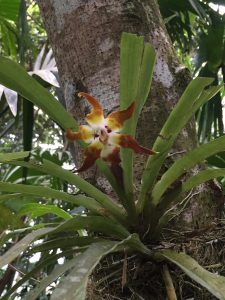Most people have seen an orchid before but there’s so much more to them than meets the eye. There are more species in the orchid family than in any other plant family. There are around 30,000 species in the world and about 1,000 species in Costa Rica. One of these species is V. planifolia, or as we know it, vanilla. Orchids are certainly a very diverse group: their size can range from three millimeters to three meters! Some orchids are terrestrial and grow from the ground but a majority of them (around 85%) are epiphytic. This means that they grow on other trees for better access to sunlight. We saw a few of these epiphytic orchids in San Gerardo. We saw orchids in the branches of trees on the trails and on the “orchid tree” which is a stump that they grow fallen orchids on.
Seeing the orchids in person really helped us understand their structure. They sometimes have a pseudobulb at the base of the stalk that can retain moisture and nutrients. This is really helpful for when an orchid is growing high up in a tree and has no way to reach the soil. The roots are unique because they are fleshy, green, and can photosynthesize. Orchid seeds are super small, like dust, and there can be millions of them in one flower! The seeds are dispersed by wind to find a suitable habitat with the right amount of moisture and certain kinds of fungus. Most of the seeds never find a viable habitat.
Orchid pollination is also very unique. Some species are self-pollinated and others are insect pollinated. Neotropical orchids are often pollinated by male orchid bees. The bees are a brilliant metallic green or blue. Unlike other pollinators that use a flower for its pollen or nectar, orchid bees scrape the petals for oil which may be used for attracting a mate. Some other species of orchids attract pollinators by mimicking a female insect with its color, shape, and odor!
Orchids are much more diverse and peculiar than I could have guessed. It was very interesting to see multiple different types, colors, and sizes of orchids on our trip.



